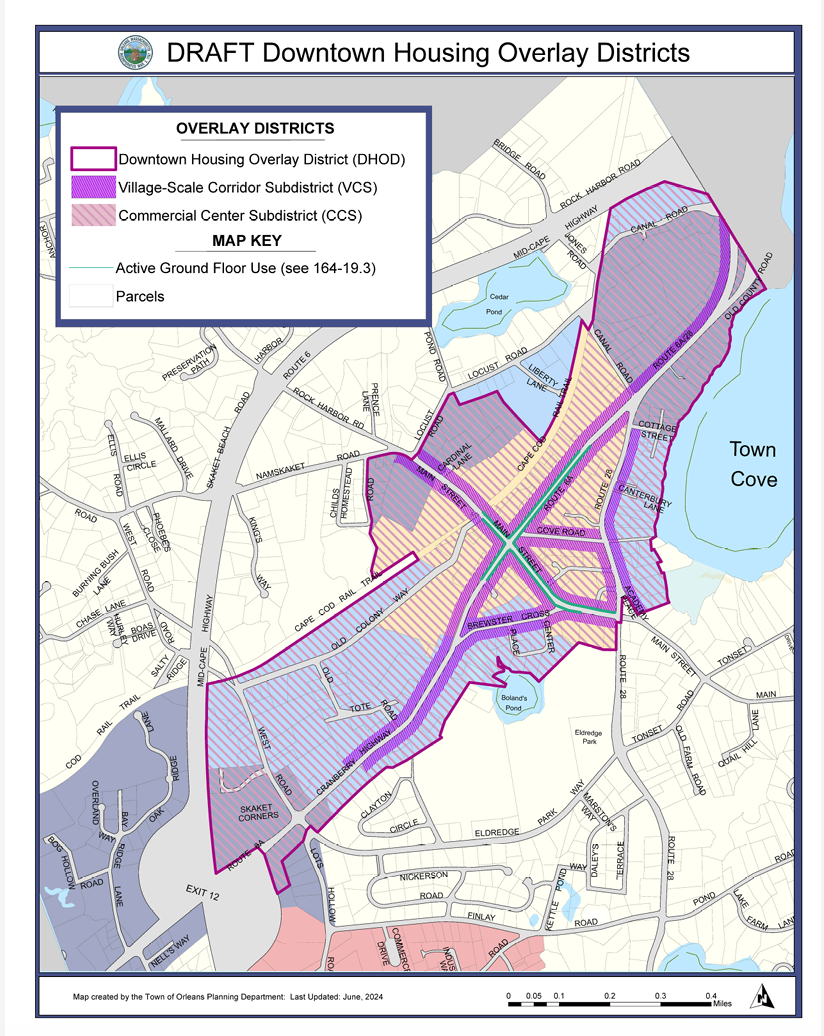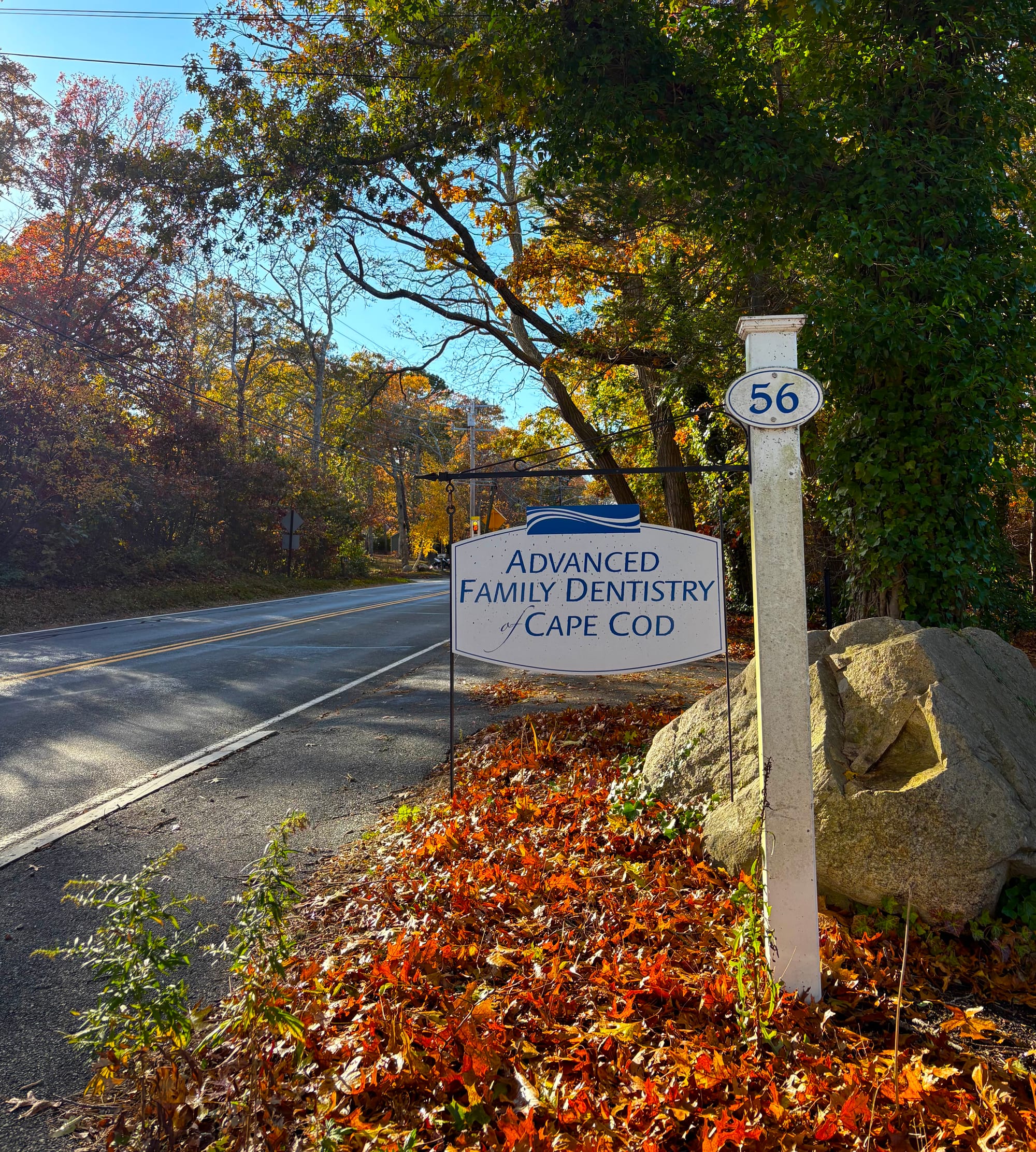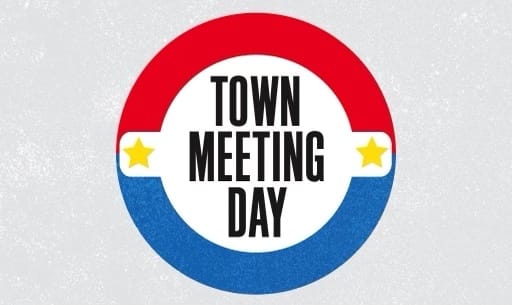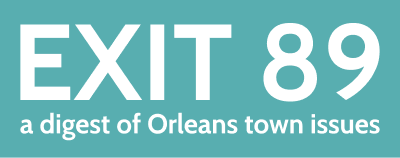Getting excited about Special Town Meeting? The Warrant has just twelve articles but LOTS of pages (and some in full color). Most of the ink is devoted to the first two articles — updating our current zoning bylaw, and establishing a new Downtown Housing Overlay District.
Zoning changes mean plenty of urban-planning jargon. Fasten your seatbelts and we’ll do our best to drive you through the weeds.
Example: What, pray tell, is an “Overlay District?”
Keep reading to unlock that mystery.
Residents will also be asked to vote on a new, enhanced energy code, funding for the Eldredge Park renovation, and a pretty darn exciting land purchase for the new Fire-Rescue Station, among other things.
First, the basics:
When: Monday, November 17, 6 PM
Where: The Nauset Regional Middle School Gym
The doors open at 4 PM, an hour earlier than usual — so that Town staff can answer your questions about articles before the meeting begins. When you arrive, you can check in, grab a handheld electronic voting gizmo, and find a seat. Bring some water, maybe a snack, and your copy of the Warrant (printed copies are available now at Town Hall — upstairs, in the Town Manager’s office). Our new HDTV Channel 1072 will record and livestream the entire meeting, but all votes must be cast in person.
What about kids? The Orleans Recreation, Culture & Community Events Department will again offer free childcare and pizza in the Middle School cafeteria from 6 to 9 PM for children ages 4 to 13. Pre-registration is required and please note: you must register by Friday, November 14. Click here to do so.
Also important: Only 600 copies of the Warrant were printed (due, in part, to the high cost of printing the snazzy, full-color illustrations required by law to explain the proposed zoning bylaw changes). As such, Town Hall requests that you take only one copy, put your name on it, and bring it with you to the meeting. (There will not be scads of extra copies available there.) For residents who prefer to access the Warrant on their phones or tablets during the meeting, there will be staff to help.
Now, about that “Overlay District” — plus a few other things. . .

Articles 1 + 2: Zoning
Thoughtful zoning is crucial to the life of any community. It can define a town’s character and economic vibrancy — enabling growth, attracting visitors and new residents, and simply making time spent there enjoyable.
Both articles propose changes to Orleans’ zoning bylaws. EXIT 89 will provide you with an overview of the changes — and wow, there’s a lot to cover! More than we can do justice to here. We encourage you to dig further into the details; you'll find a list of ways to do that at the end of our preview.
Let’s dive in. . .
Article 1 is a comprehensive technical update of Orleans' zoning bylaw. As Assistant Town Planner Elizabeth Jenkins told the Select Board on October 22nd, it would replace the current bylaw with one that is “organized and consistent throughout.”
The current one, last rewritten in the 1980s, is neither of those, according to Jenkins, who said that after decades of amendments, it is “difficult to navigate.” The proposed reorganization and update aims to create a more user-friendly document by 1) grouping related regulations together for easier identification and navigation, and 2) ensuring consistent numbering, terms, references, and tables. The full text of the amended bylaw is on pages 49-124 of the Warrant. Important to note: Article 1 does not make any policy or regulatory changes.

Article 2 is another story. It proposes the creation of a Downtown Housing Overlay District — a re-envisioning of Orleans’ downtown area intended to encourage more affordable and market-rate housing and mixed-use development now that it’s connected to the sewer. (For those not versed in urban planning jargon, an “overlay district” is a part of a city or town with its own zoning regulations.) Years of gathering community input have shown Orleans residents support these goals. Residents also want more bikeability and walkability, access to public transportation, economic vibrancy, and thoughtful design — while maintaining Orleans’ traditional seaside-village charm and protecting our waters.
Within the Overlay District — see map above — half of the new residential units would be deed-restricted for year-round occupancy, and developments of ten or more units would be required to make 25 percent of the housing affordable or attainable.
What else would the new Overlay District determine? Lot standards (building placement, separation, number of buildings, and open space); building standards (height, number of stories, façade articulation, fenestration, entry types, and other architectural features); and site standards including parking (how much is needed, where it would be located, how it’s accessed), curb cuts, bicycle parking, loading, service areas, and landscape/stormwater management.
Worth noting: The proposed Overlay District is optional for developers; they can still use the “old” zoning rules if they choose.
Also of note: There are two sub-districts within the Overlay District. The Village-Scale Corridor Sub-district — see map above — has street-fronting sections of Main Street, 6A, Brewster Cross, and Cove Road within the village center and other parts of Route 6A. It would require smaller buildings to be built close to the street to keep things looking historic and village-y. How small? Buildings would be limited to 2.5 stories unless there’s an occupancy restriction to lower- and middle-income residents and year-rounders, in which case they could be 3.5 stories.
The Commercial Center Sub-district — see map — focuses on denser, but still small-scale, housing development: 3.5-story residential buildings with maximum footprints of 8,000 square feet, and the option of going up to 10,000 square feet if the building’s occupancy is restricted to year-round, lower- and middle-income residents.
Pages 5-32 of the Warrant explain and illustrate the proposed Overlay District in full. Be warned: It’s a lot to take in — at least for your average Joe or Jane or EXIT 89 journalist. If you’re looking for supporting materials, watch a detailed presentation on the proposed downtown changes and visit the Planning Department’s web page devoted to the Housing Overlay District for all kinds of information, including why we need an Overlay District, how it was developed, and what Orleans could look like in a few years. There are also maps, videos of public presentations, and slide decks, plus a series of public meetings with Elizabeth Jenkins and others this week to help get you up to speed. (You’ll find dates and times at the bottom of this issue.)
Both the Select Board and Finance Committee voted unanimously in support of both zoning articles. Article 1 requires a two-thirds vote at the meeting to pass. Article 2 requires a simple majority.

Article 3: Adopt New Energy Code?
Here's another doozy with lots of things to consider. A protracted debate over adopting a stricter, more energy-efficient building code occurred at the Special Town Meeting in October 2023, when several factions — including climate-change skeptics, anti-regulation crusaders, and some builders — opposed it.
The new code, or Specialized Energy Code, is an update to the Stretch Energy Code currently in use, and aligns Orleans with the Commonwealth’s updated goals of reducing carbon emissions and dependence on fossil fuels. In Orleans, the higher standard would apply to new construction, both residential and commercial, with a list of exemptions. While a majority of residents have shown support for environmental initiatives in the past, after 32 minutes of debate the new code failed two years ago by a narrow margin: 179 yeas to 189 nays.
Now it’s on the Warrant again.
Will the conversation be any different this time around?
Here’s the history. Eight years ago Orleans applied to be designated as a “Green Community,” demonstrating residents’ support for making our town more energy-efficient and less dependent on fossil fuels. Being a Green Community (one of 297 in the state) comes with perks, like state support for de-carbonization initiatives and access to grants. To keep pace with the Commonwealth’s and Select Board’s goals — a mandate of net-zero emissions by 2050 — new measures were developed.
In 2020 Orleans applied for a new designation, “Climate Leader Community,” making the town eligible for more energy-related infrastructure and technical-assistance grants. Which brings us to the present moment. For Orleans to complete its designation as a Climate Leader Community, it must adopt the Specialized Energy Code by December 2025.
The program’s website describes the Specialized Energy Code requirements as “designed to ensure new construction that is consistent with 2050 net-zero goals, primarily through deep energy efficiency, reduced heating loads, and efficient electrification.” If approved, the new code would go into effect July 1, 2026.
Pros: Supporters say we need to end our dependence on fossil fuels, a major cause of climate change. Yes, some costs will go up, but the Select Board, Energy & Climate Action Committee, and supporters like the Community Development Partnership believe that the long-term savings will outweigh cost increases. They argue the costliest requirements of the Specialized Code apply to only new, very large houses (4,000 square feet and above) and large municipal and multi-family construction (12,000 square feet, four stories or more). These changes are coming down the road, they contend, and will very likely become mandatory rather than “opt-in.” Moving to all-electric or electric-ready new construction will be easier — and cheaper — if we do it now. Another reason: being out front as an early adopter of the new code has financial advantages. As more and more Commonwealth communities become designated Climate Leaders — there are currently 19, with the Massachusetts Department of Energy and Resources (DOER) anticipating at least nine more designee towns soon — competition for grant money will get tougher.
Cons: At Town Meeting two years ago, some residents raised doubts about the environmental benefits of electricity over gas; others cited governmental overreach and encroachment on individual liberties; still others feared the burdensome nature of the enhanced regulations, along with increased up-front costs. These concerns remain, along with new ones. For example, electricity rates have escalated rapidly in the last four years — faster than inflation — making some question the financial impact of “all-electric” buildings. The Cape’s fragile electrical grid and its ability to cope with increased demand is another serious concern, along with the unburied power lines.
At the Affordable Housing Trust Fund (AHTF) meeting on November 4, the board voted against (4 against, 2 in favor, 2 abstentions) Article 3. The meeting clearly illustrated the conflict between a mission to address our housing crisis and the desire to be more energy efficient. Arguing against the new code, Peter Kimball of M. Duffany Builders said construction costs are “already astronomically high” and that adopting the new code “moves Massachusetts from the strictest energy code in the country to even more draconian measures.“ Builder Aaron Polhemus of Polhemus Savery DaSilva also opposed the new code, saying: “The complexity itself is a concern.” He described the homes built now in Orleans as “really efficient” already and added, “I think we need to be really careful.”
Supporters of the article at the AHTFB meeting pointed out that new, income-restricted homes in Orleans — at both 107 Main Street and 19 West Road — are already all-electric, so they wouldn’t be affected by the new code. Also, they said, the large multi-family housing — described by the builders as an example of the exorbitant costs we would face by adopting the new code — isn’t allowed in Orleans under current zoning laws, and therefore not a concern.
On November 6, representatives from DOER told the Energy and Climate Action Committee that the main reason to adopt the code was its pre-wiring requirement, which would save money on future retrofits and expedite the move to electricity. They also said that adoption of the code would not discourage the building of affordable housing because of significant State incentives, and pointed to lower utility costs for tenants, higher indoor air quality, and greater comfort.
Lots to chew on, no?
While chewing, you can watch a presentation about the Specialized Code here and a video of a November 6 meeting of the Energy & Climate Action Committee here. You can look at DOER's well-done comparison between the Stretch and Specialized codes and watch the November 4 AHTF board meeting when its vote was taken. Finally, for a full-plunge into the broader debate about climate change and climate-change strategies — with ideas about how to make the difficult decisions facing all of us — here’s a recent essay by Bill Gates.
Article 3 was supported (4-0) by the Select Board. The Finance Committee was split (5-4-0) in narrow support. It requires a simple majority vote to pass.

Articles 4-6: Addressing the Housing Crisis
Orleans has been a leader on the Cape in addressing the housing crisis — which remains a priority for residents and Town Hall. These three articles aim to encourage year-round rentals, support the creation of more housing, and shift some of our infrastructure costs to the short-term rental industry.
Here’s the scoop:
Article 4 proposes authorizing the Select Board to establish a property tax exemption for property owners who rent homes year-round at affordable rates. If voters accept the Local Option provision of Massachusetts General Law Ch 59 Sec. 5 O, it would be up to the Select Board to set the specifics of the exemption for Orleans, including income limits, rent levels, and maximum exemption amounts, plus any other “restrictions or regulations consistent with the intent of the law it elects to implement.” This exemption would be added to the list of current real estate property tax exemptions offered by the Town of Orleans, which include exemptions for seniors, vets, the sight-impaired, and others. (There is also a property tax deferral program for seniors, allowing eligible homeowners to delay payment of all or a portion of their property taxes until the property is sold or the owner passes away.) Article 4 was supported unanimously by the AHTFB and Select Board, and also by a split Finance Committee (4-3-0). It requires a simple majority vote to pass.
Article 5 would establish a new Community Impact Fee of 3 percent on professionally-managed short-term rentals. What qualifies as “professionally-managed?” Answer: A property managed by an operator or owner who is managing two or more short-term rental units in town. The fee would be collected by the Commonwealth and then returned to Orleans quarterly to be used for specific community needs. Massachusetts law requires at least 35 percent go to affordable housing or local infrastructure projects; the Select Board determined that 75 percent would go toward affordable housing and 25 percent toward local infrastructure. (To read EXIT 89’s deep dive on short-term rentals in Orleans, click here.) Article 5 was supported unanimously by the AHTFB and Select Board, and by a split Finance Committee (5-4-0), some of whose members found the definition of “professionally-managed” unclear. It requires a simple majority vote to pass.
Article 6 creates a special-purpose stabilization fund, as required by the State, for the community impact fees beginning in July, 2026, if Article 5 passes. The article was supported unanimously by the AHTFB and Select Board, and by a split Finance Committee (6-3-0). It requires a two-thirds vote to pass.

Article 8: Land Acquisition for Fire-Rescue
Sighs of relief were heard ‘round Orleans when it was announced that the Town had reached an agreement with Dr. Greg Monfette, owner of Advanced Family Dentistry of Cape Cod at 56 Eldredge Park Way, to purchase his .82 acre property that abuts the current Orleans Fire-Rescue Station.
The price is $1.35 million — to come from the Town’s General Stabilization Fund, thus having no impact on taxes. The article was supported unanimously by both the Select Board and Finance Committee. A two-thirds vote at Special Town Meeting is required for it to pass.
As reported in EXIT 89’s recent updates issue, there have been many questions raised over the exact siting of the proposed new station, given the constraints of the existing property, including its proximity to Orleans Elementary School (OES).This land acquisition could go a long way toward resolving that, and some of the project’s other challenges. Eliminating the need for a temporary station could save an estimated $13.5 million, according to previous feasibility studies, and siting the new station closer to Eldredge Park Way would improve response times and save on construction costs.
Under the current terms of the sale being discussed, Dr. Monfette’s practice could remain at its current site through June 2027.
Meanwhile, the Town Manager’s office has said it is “continuing to investigate” other potential land use opportunities.
Hmm. . .
What does the project timeline look like now?
Good question. The Town has hired Pomroy Associates as the Owner’s Project Manager (OPM). Pomroy worked with the Orleans Fire-Rescue Building Committee to issue a Request for Qualifications (RFQ) for design services for the new station, in hopes of having an architect/designer on board by the end of 2025. While the Select Board and Town Hall officials still hope a full design and cost estimate will be ready for a vote at the May 2026 Town Meeting, Rick Pomroy, Principal of Pomroy Associates, told the Fire Rescue Building Committee on October 27 that even completing a schematic (architecture-speak for preliminary) design by then will be a stretch.

Article 9: Eldredge Park Renovation
The planned update to Eldredge Park, the biggest and most-used recreation area in Orleans, has proven to be a wildly popular project with residents. And in an unexpected twist last month, the Community Preservation Committee (CPC) voted to step in and fund it.
If you missed this development, you can watch the October 2 CPC meeting where the decision was made or read EXIT 89’s overview.
Where are we now?
Residents are being asked to approve a $3 million bond for the CPC to help finance the proposed renovation.
Both the CPC and Select Board have expressed enormous enthusiasm for the project, which would create two new tennis courts, six new pickleball courts, a full basketball court and separate halfcourt, a new handball court, a new children’s playground with a tricycle track, more parking and accessible walking trails, along with benches, shaded areas, extensive night-lighting, water bottle stations, and handicapped parking. The current estimate for the project is $5.5 million.
Why is the bond amount $3 million when the project is estimated to cost $5.5 million? For starters, there are other available funds: $850,000 that was approved at Town Meeting (of which $100,000 was spent on the Weston & Sampson study), and another $100,000 previously approved for the development of pickleball courts that hasn't been spent yet. The current estimate also includes a 20 percent contingency line item or “cushion.”
Due to the way construction projects are financed, the actual bond would not be issued until the work is completed — and that’s projected to be early 2028.
A project of this size would be a major commitment for the CPC — it's largest bond ask ever. Each year, its nine appointed members are tasked with selecting from a large pool of applications, and then appropriating funds to a dozen or so worthy projects — often affordable housing or restoration projects, such as Odd Fellows Hall or Academy Playhouse. CPC funds come from a local surcharge of 3 percent on Orleans property tax bills and contributions from the State. The anticipated total for FY26 is slightly over $1.4 million. These must be used for one of four categories: affordable housing, open space, historic preservation, or outdoor recreation.
Upon completion of the Eldredge Park work, and for several years after, a significant chunk of the CPC’s available funding would go toward repaying the bond principal and debt service. This means other groups seeking funding could get squeezed. Article 9 was supported unanimously by both the Select Board and Finance Committee and requires a three-quarters vote to pass because of the bonding.

Article 10: Wastewater Continued. . .
This is a recurring budget line item: $150,000 from the Wastewater Stabilization Fund for engineering, planning, and public outreach support for our epic wastewater project. Phase 2 will be completed at the end of 2025. Planning for Phase 3 is underway. (For more background, see a map of the phases, read the wastewater management plan and the FAQs of wastewater collection, or dive into EXIT 89’s “Water, Water, Everywhere” — a comprehensive study of water in Orleans.) Article 10 was supported unanimously by the Select Board and Finance Committee and requires a simple majority vote to pass.

Going Deeper
Town Hall is standing by to help educate and inform. It's Town Meeting Central page has links to videos, presentations, and explanations of each article. If you have more questions, residents are asked to contact the Town Manager’s office or visit Orleans Town Hall during business hours.
Or, even better, there’s a series of informal public discussions of the Warrant being offered this week:
Wednesday, November 12 from 4-6 PM in the Nauset Room of Town Hall
Thursday, November 13 from 12-1:30 PM at Snow Library
Friday, November 14 from 9-10:30 AM at the Council on Aging
Orleans Citizens Forum will hold its always-helpful discussion of the Warrant on November 13 from 5:30-7 PM at LCTV, 5 Namskaket Rd, Orleans. You can attend remotely via Zoom.
See you at the meeting!

EXIT 89 is an independent publication. Our mission is to help Orleans voters make sense of town issues by providing a clear and impartial overview of the latest developments. We want to help fill the information gap, reduce the "mystery" of Town Meeting, and promote vibrant civic engagement.
Our hyperlocal digest is researched and written by journalists Martha Sherrill and Emily Miller. Elaine Baird and Lynn Bruneau are the founding advisors. We are all residents of Orleans. Editing, infographics and tech support are provided by Kazmira Nedeau of Sea Howl Bookshop. Additional research and writing for this issue was provided by Orleans resident Steve Gass. Thanks, Steve!
Our digest is 100 percent free — and we aim to keep it that way. But your donations keep us going. You can donate securely online by clicking here. Or you can send a check to "EXIT 89" and save us a processing fee. Our address is: EXIT 89, P.O. Box 1145, Orleans, MA 02653.
As always, we’d love to hear from you. Please share questions, comments, and ideas for future issues at hello@exit89.org. If you are new to EXIT 89, please take a moment to sign up for a free subscription. And if you’ve been here a while and enjoy it, please forward to a friend.
As always, thank you for your support!

